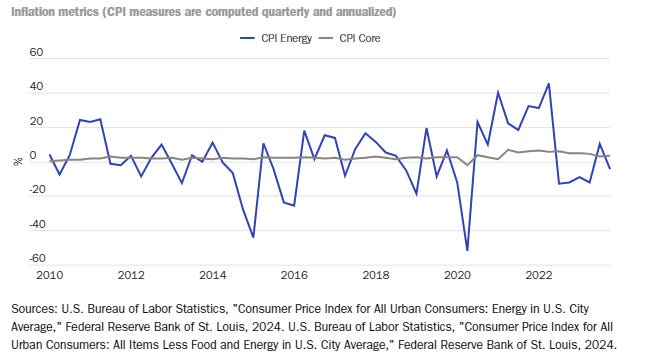Inflation Is Still Trending in the Right Direction
A few months of hotter‐than‐expected inflation numbers have led to a renewed debate around how entrenched inflation has become. Most recently, the February Consumer Price Index increased 0.4% (4.8% annualized), driven primarily by shelter and gasoline which accounted for 60% of the overall increase in price level. Energy increased by a massive 2.3% in February alone. Despite these scary numbers, inflation is still trending in the right direction. This article will show that the elevated components of inflation—shelter and energy—do not accurately portray economic conditions.
In a free market‐based economy such as the US, a central bank should do as little as possible since most economic fluctuations revert to trend through stronger and more informed market forces. When a (well‐intentioned) central bank responds to incorrect price signals, it risks causing further damage by unnecessarily crushing credit markets and dampening real activity. The Fed rushing to respond to February’s elevated inflation would be an example of such a mistake.
Figure 1 shows two measures of CPI inflation—owners’ equivalent rent (OER) and the aggregate index less shelter since 2010. Both inflation metrics are computed by calculating the percent change of their respective quarterly price indices and then annualized (multiplied by 4). The aggregate metric was high post‐pandemic but eventually started to fall in late 2022. Aggregate inflation less shelter maintained this downward trend and remained below 2% through most of 2023. The graph shows—especially since the pandemic—that shelter inflation as measured through the OER significantly trails the rest of the CPI. (In economist speak, it is a lagged measure.) OER inflation hit its peak 2 quarters after other price measures and similarly lagged in its recovery back towards trend.
Rather than indicating that inflation is entrenched, this increase in the OER is an indicator that shelter prices increased some time back. The problem is that those price increases are just now showing up in the CPI.
Figure 1 also shows median consumer one‐year ahead inflation expectations as collected by the Michigan Survey of Consumers. Keeping expectations anchored is a vital component of managing inflation and this metric too is trending down since its post‐pandemic high. It is important to note that median expectations are slow to adjust and typically do not fluctuate drastically, as the graph shows. The series trended gently upward during the worst of the inflationary episode, and it is likewise gently trending down. Again, this does not indicate that high inflation is entrenched. Instead, it offers further evidence that long‐term inflation is headed in the right direction.
When can shelter prices be expected to catch up with the rest of the economy’s prices? Figure 2 shows the cross‐correlations between the two CPI inflation metrics from Figure 1. Cross‐correlations measure the similarity between any time series and a lagged version of another time series. Plotting the cross‐correlation between these series at a variety of lags, as done in Figure 2, allows a researcher to determine the lag length at which the two series are most similar. The figure shows that CPI OER inflation is most similar to the aggregate of all other CPI components at a lag of 3 to 5 quarters. This suggests that consumers will likely have to wait 9 to 15 months to see rent prices follow the rest of the economy and revert to trend. (It is also important to note from Figure 1 that OER inflation trend is higher than the other metrics; it is reasonable to expect rent inflation to fall but not to the level of other price inflation metrics.)
Reporting on inflation has also expressed concern over its other elevated component—energy. Figure 3 compares CPI energy inflation and core (i.e., less food and energy) CPI inflation since 2010. Both metrics are computed like the inflation metrics from Figure 1.
As the chart shows, inflation volatility in the energy sector is significantly higher than the core CPI. Values for energy inflation range from ‑52% to +45% in this period. Core CPI inflation only fluctuates between ‑2% to +7%. Since 2010, the standard deviation of energy CPI inflation is 18.49% while core CPI is only 1.64%; as such, energy price inflation is over 11 times as volatile as the core CPI. Like rent inflation, energy inflation does not accurately reflect any truths about the current and future path of inflation—it is simply too volatile and acts in a very different manner to core CPI. It should not be used to express concern about elevated price levels.
To be clear, it is useful and informative to have reporting on a variety of inflation metrics. The concern is if policymakers base their decisions on improper price metrics. If the Fed were to intervene and discretionarily react to short‐term price fluctuations that stem from rents or energy, it would only exacerbate current economic problems. For example, an improper rate increase could further tighten credit markets, increasing default rates on mortgages or credit card debt that are already very high. Sound policymaking accounts for such distinctions. Despite the hotter than expected inflation numbers, the conclusion to be drawn remains that aggregate inflation continues to trend down.
Read the Cato-at-Liberty blog post here.






